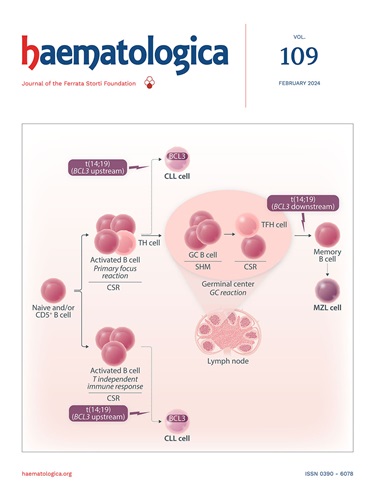158例接受双特异性抗体治疗的复发/难治性多发性骨髓瘤患者的感染风险:单中心研究
IF 7.9
1区 医学
Q1 HEMATOLOGY
引用次数: 0
摘要
四种双特异性抗体(BsAbs)被批准用于治疗复发性难治性多发性骨髓瘤(RRMM),但它们的使用与感染风险相关,需要缓解策略。这项单中心回顾性研究评估了158例接受bsab治疗的RRMM患者感染的发生率、病因和危险因素。101例患者接受BCMAxCD3 BsAb (teclistamab和elranatamab), 57例患者接受GPRC5DxCD3 BsAb (talquetamab)。预防措施包括带状疱疹和肺囊虫覆盖,以及每月静脉注射免疫球蛋白(IVIG)作为初级预防措施。Tocilizumab用于预防细胞因子释放综合征和免疫效应细胞相关神经毒性综合征,缓解患者的BsAb频率降低。每月评估巨细胞病毒(CMV)病毒载量。抗bcma组和抗gprc5d组的中位随访时间分别为6.1个月和4.5个月。抗bcma组5个月和10个月首次感染的累积发生率分别为38.6%和47.9%,抗gprc5d组分别为28.1%和30.3% (p=0.06)。多因素分析显示,IVIG可显著降低≥3级感染的风险(HR 0.38, p。本文章由计算机程序翻译,如有差异,请以英文原文为准。
Infection risk in 158 patients with relapsed/refractory multiple myeloma treated with bispecific antibodies: a single-center experience.
Four bispecific antibodies (BsAbs) are approved for the treatment of relapsed refractory multiple myeloma (RRMM), but their use is associated with infection risks, requiring mitigation strategies. This single-center retrospective study evaluated the incidence, etiology, and risk factors for infections in 158 RRMM patients treated with BsAbs. A total of 101 patients received BCMAxCD3 BsAbs (teclistamab and elranatamab), and 57 GPRC5DxCD3 BsAb (talquetamab). Prophylactic measures included herpes zoster and Pneumocystis jirovecii coverage, along with monthly intravenous immunoglobulin (IVIG) as primary prophylaxis. Tocilizumab was used for the prevention of cytokine release syndrome and immune effector cell-associated neurotoxicity syndrome, and BsAb frequency was reduced in responding patients. Cytomegalovirus (CMV) viral load was assessed monthly. Median follow-up was 6.1 vs. 4.5 months for anti-BCMA vs. anti-GPRC5D group. The cumulative incidence of the first any-grade infection at 5 and 10 months was 38.6% and 47.9% in the anti-BCMA group, and 28.1% and 30.3% in the anti-GPRC5D group (p=0.06). IVIG administration significantly reduced the risk of grade ≥3 infections in multivariate analysis (HR 0.38, p.
求助全文
通过发布文献求助,成功后即可免费获取论文全文。
去求助
来源期刊

Haematologica
医学-血液学
CiteScore
14.10
自引率
2.00%
发文量
349
审稿时长
3-6 weeks
期刊介绍:
Haematologica is a journal that publishes articles within the broad field of hematology. It reports on novel findings in basic, clinical, and translational research.
Scope:
The scope of the journal includes reporting novel research results that:
Have a significant impact on understanding normal hematology or the development of hematological diseases.
Are likely to bring important changes to the diagnosis or treatment of hematological diseases.
 求助内容:
求助内容: 应助结果提醒方式:
应助结果提醒方式:


